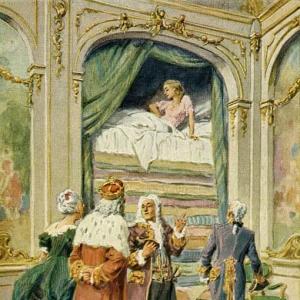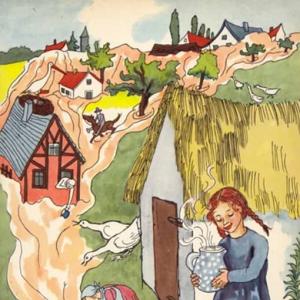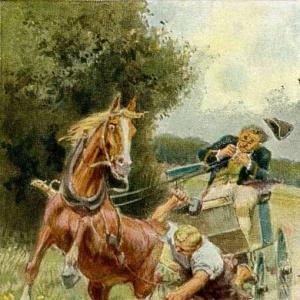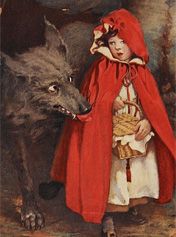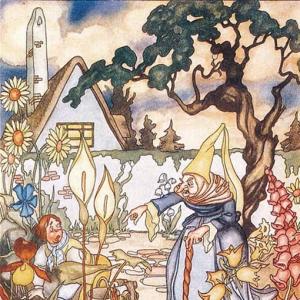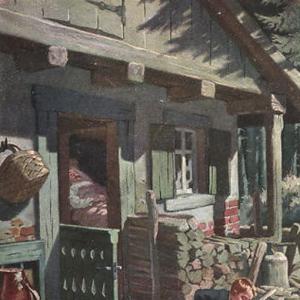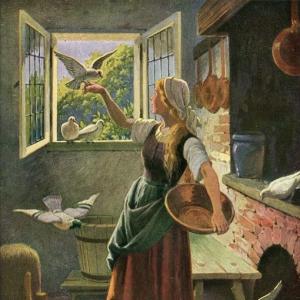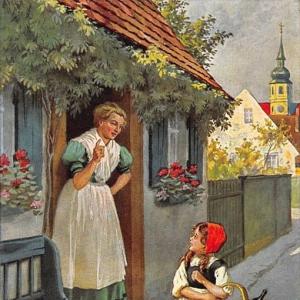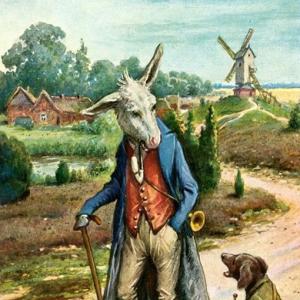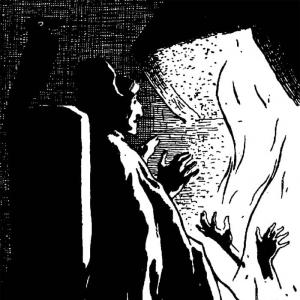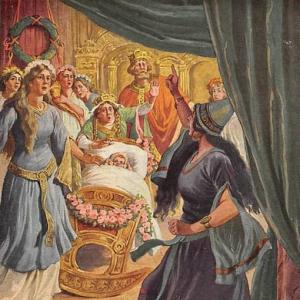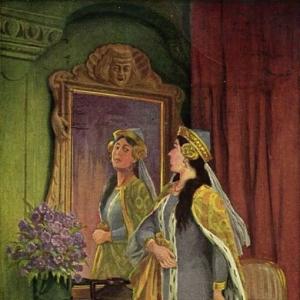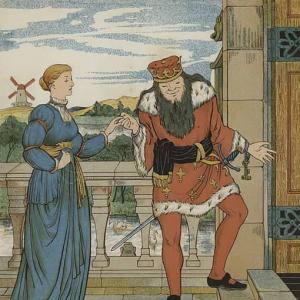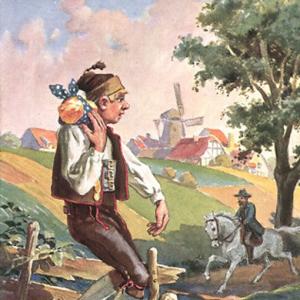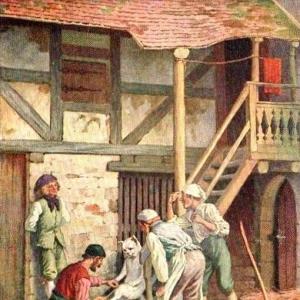Reading time for children: 11 min
In a certain mill lived an old miller who had neither wife nor child, and three apprentices served under him. As they had been with him several years, he one day said to them, „I am old, and want to sit in the chimney-corner, go out, and whichsoever of you brings me the best horse home, to him will I give the mill, and in return for it he shall take care of me till my death.“ The third of the boys was, however, the drudge, who was looked on as foolish by the others. They begrudged the mill to him, and afterwards he would not have it. Then all three went out together, and when they came to the village, the two said to stupid Hans, „Thou mayst just as well stay here, as long as thou livest thou wilt never get a horse.“ Hans, however, went with them, and when it was night they came to a cave in which they lay down to sleep. The two sharp ones waited until Hans had fallen asleep, then they got up, and went away leaving him where he was. And they thought they had done a very clever thing, but it was certain to turn out ill for them. When the sun arose, and Hans woke up, he was lying in a deep cavern. He looked around on every side and exclaimed, „Oh, heavens, where am I?“ Then he got up and clambered out of the cave, went into the forest, and thought, „Here I am quite alone and deserted, how shall I obtain a horse now?“ Whilst he was thus walking full of thought, he met a small tabby-cat which said quite kindly, „Hans, where are you going?“ – „Alas, thou canst not help me.“ – „I well know your desire,“ said the cat. „You wish to have a beautiful horse. Come with me, and be my faithful servant for seven years long, and then I will give you one more beautiful than any you have ever seen in your whole life.“ – „Well, this is a wonderful cat!“ thought Hans, „but I am determined to see if she is telling the truth.“ So she took him with her into her enchanted castle, where there were nothing but cats who were her servants. They leapt nimbly upstairs and downstairs, and were merry and happy. In the evening when they sat down to dinner, three of them had to make music. One played the bassoon, the other the fiddle, and the third put the trumpet to his lips, and blew out his cheeks as much as he possibly could. When they had dined, the table was carried away, and the cat said, „Now, Hans, come and dance with me.“ – „No,“ said he, „I won’t dance with a pussy cat. I have never done that yet.“ – „Then take him to bed,“ said she to the cats. So one of them lighted him to his bed-room, one pulled his shoes off, one his stockings, and at last one of them blew out the candle. Next morning they returned and helped him out of bed, one put his stockings on for him, one tied his garters, one brought his shoes, one washed him, and one dried his face with her tail. „That feels very soft!“ said Hans. He, however, had to serve the cat, and chop some wood every day, and to do that, he had an axe of silver, and the wedge and saw were of silver and the mallet of copper. So he chopped the wood small; stayed there in the house and had good meat and drink, but never saw anyone but the tabby-cat and her servants. Once she said to him, „Go and mow my meadow, and dry the grass,“ and gave him a scythe of silver, and a whetstone of gold, but bade him deliver them up again carefully. So Hans went thither, and did what he was bidden, and when he had finished the work, he carried the scythe, whetstone, and hay to the house, and asked if it was not yet time for her to give him his reward. „No,“ said the cat, „you must first do something more for me of the same kind. There is timber of silver, carpenter’s axe, square, and everything that is needful, all of silver, with these build me a small house.“ Then Hans built the small house, and said that he had now done everything, and still he had no horse. Nevertheless the seven years had gone by with him as if they were six months. The cat asked him if he would like to see her horses? „Yes,“ said Hans. Then she opened the door of the small house, and when she had opened it, there stood twelve horses, such horses, so bright and shining, that his heart rejoiced at the sight of them. And now she gave him to eat and drink, and said, „Go home, I will not give thee thy horse away with thee; but in three days‘ time I will follow thee and bring it.“ So Hans set out, and she showed him the way to the mill. She had, however, never once given him a new coat, and he had been obliged to keep on his dirty old smock-frock, which he had brought with him, and which during the seven years had everywhere become too small for him. When he reached home, the two other apprentices were there again as well, and each of them certainly had brought a horse with him, but one of them was a blind one, and the other lame. They asked Hans where his horse was. „It will follow me in three days‘ time.“ Then they laughed and said, „Indeed, stupid Hans, where wilt thou get a horse?“ – „It will be a fine one!“ Hans went into the parlour, but the miller said he should not sit down to table, for he was so ragged and torn, that they would all be ashamed of him if any one came in. So they gave him a mouthful of food outside, and at night, when they went to rest, the two others would not let him have a bed, and at last he was forced to creep into the goose-house, and lie down on a little hard straw. In the morning when he awoke, the three days had passed, and a coach came with six horses and they shone so bright that it was delightful to see them! and a servant brought a seventh as well, which was for the poor miller’s boy. And a magnificent princess alighted from the coach and went into the mill, and this princess was the little tabby-cat whom poor Hans had served for seven years. She asked the miller where the miller’s boy and drudge was? Then the miller said, „We cannot have him here in the mill, for he is so ragged. He is lying in the goose-house.“
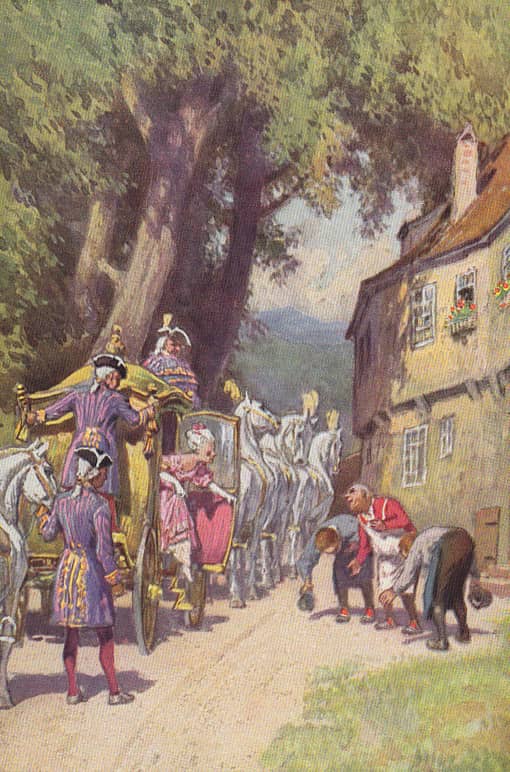
Then the King’s daughter said that they were to bring him immediately. So they brought him out, and he had to hold his little smock-frock together to cover himself. The servants unpacked splendid garments, and washed him and dressed him, and when that was done, no King could have looked more handsome. Then the maiden desired to see the horses which the other apprentices had brought home with them, and one of them was blind and the other lame. So she ordered the servant to bring the seventh horse, and when the miller saw it, he said that such a horse as that had never yet entered his yard. „And that is for the third miller’s boy,“ said she. „Then he must have the mill,“ said the miller, but the King’s daughter said that the horse was there, and that he was to keep his mill as well, and took her faithful Hans and set him in the coach, and drove away with him. They first drove to the little house which he had built with the silver tools, and behold it was a great castle, and everything inside it was of silver and gold; and then she married him, and he was rich, so rich that he had enough for all the rest of his life. After this, let no one ever say that anyone who is silly can never become a person of importance.
 Learn languages. Double-tap on a word.Learn languages in context with Childstories.org and Deepl.com.
Learn languages. Double-tap on a word.Learn languages in context with Childstories.org and Deepl.com.Backgrounds
Interpretations
Adaptions
Summary
Linguistics
„The Poor Miller’s Boy and the Cat“ is a fairy tale from the collection of German folk tales known as „Kinder- und Hausmärchen“ (Children’s and Household Tales) compiled by the Brothers Grimm, Jacob and Wilhelm. This collection, first published in 1812, contains over 200 stories that have become popular worldwide, including classics such as „Cinderella,“ „Rapunzel,“ and „Snow White.“
The Brothers Grimm were linguists, cultural researchers, and authors who lived in Germany during the late 18th and early 19th centuries. They were committed to preserving German folklore and traditional stories, which they believed were essential to understanding the nation’s culture and history. To collect these stories, the brothers interviewed people from various social classes and regions, as well as referenced written sources.
„The Poor Miller’s Boy and the Cat“ is not as well-known as some of the other tales in the collection, but it still conveys important themes and morals, such as the transformative power of love, the importance of inner worth, and the value of perseverance. The story reflects the societal norms and values of the time when it was collected, including the emphasis on hard work and the belief in supernatural beings, such as talking animals and enchanted castles.
„The Poor Miller’s Boy and the Cat“ can be interpreted in several ways, each highlighting different themes and morals. Here are a few interpretations:
Perseverance and hard work: Despite being underestimated and ridiculed by others, Hans stays determined and focused on his goals. He completes the tasks assigned by the cat, even when they seem impossible. This perseverance eventually leads to his success and happiness.
Inner worth vs. outward appearance: Hans is initially judged by his appearance and dismissed as foolish by his peers. However, through his actions and the cat’s guidance, he demonstrates his inner qualities, such as kindness, loyalty, and determination. In the end, his true worth is recognized and rewarded.
The transformative power of love and kindness: The cat, who is later revealed to be a princess, chooses Hans because of his genuine, kind nature. Through her guidance, Hans is transformed from a poor, ridiculed boy into a successful and respected man. This demonstrates the power of love and kindness to bring about positive change in a person’s life.
The importance of staying true to oneself: Despite being mocked and mistreated by others, Hans remains true to himself and his values. He does not try to fit in or change his behavior to please others. In the end, it is his authenticity and inner strength that lead to his success and happiness.
The folly of underestimating others: The other apprentices and the miller underestimate Hans and treat him poorly based on their assumptions about his worth. This story demonstrates the danger of underestimating others and the importance of recognizing the potential in everyone, regardless of their appearance or perceived abilities.
„The Poor Miller’s Boy and the Cat“ is a classic fairy tale that has been adapted in various forms of media. Here are some notable adaptations:
„Puss in Boots“ (1697): This French fairy tale by Charles Perrault shares many similarities with „The Poor Miller’s Boy and the Cat“ and is widely considered to have inspired the Grimm brothers‘ version. In „Puss in Boots,“ a clever cat helps his poor master win the heart of a princess and become a wealthy lord.
„The Master Cat; or, Puss in Boots“ (animated film, 1934): This animated short film by Walt Disney was the first sound adaptation of „Puss in Boots.“ It tells the story of a poor miller’s son and his talking cat, who use their wits to win the hand of a princess and defeat an evil sorcerer.
„The Adventures of Puss in Boots“ (animated series, 2015): This Netflix animated series follows the adventures of the swashbuckling Puss in Boots as he protects the city of San Lorenzo from evil forces. While not a direct adaptation of the Grimm brothers‘ story, it draws inspiration from the same source material.
„The True Story of Puss ’n Boots“ (animated film, 2009): This French animated film reimagines the story of Puss in Boots as a swashbuckling adventure that takes place in a magical kingdom.
„The Master Cat“ (opera, 1913): This one-act opera by César Cui is based on Perrault’s „Puss in Boots“ and follows the story of a poor miller’s son and his clever cat as they outwit a greedy king.
Overall, „The Poor Miller’s Boy and the Cat“ has inspired numerous adaptations in various forms of media, showcasing the enduring appeal of this classic fairy tale.
„The Poor Miller’s Boy and the Cat“ is a fairy tale by Brothers Grimm, which tells the story of a poor miller’s boy named Hans, who is abandoned by his fellow apprentices in a cave. Hans then encounters a talking cat, who offers him a beautiful horse if he becomes her faithful servant for seven years. He accepts and accompanies the cat to her enchanted castle, inhabited by cat servants.
During his seven years of service, Hans is treated well, but is required to complete various tasks using silver tools. After fulfilling his duties, he asks for his reward, but the cat insists he must first build a small house. Despite feeling frustrated, Hans completes the task, and the cat reveals twelve beautiful horses. She tells him she will follow him in three days with his horse.
Hans returns home, where he is ridiculed by the other apprentices for his ragged appearance. He is given a small meal and forced to sleep in a goose-house. After three days, the cat arrives, transformed into a beautiful princess, and requests to see Hans. He is cleaned and dressed in splendid garments, becoming unrecognizable. The princess reveals that the magnificent seventh horse is for Hans, who is then allowed to keep the mill as well.
The story concludes with Hans and the princess marrying, and Hans becoming incredibly wealthy. The moral of the story is that even someone considered foolish can achieve great things in life.
The fairy tale „The Poor Miller’s Boy and the Cat“ by the Brothers Grimm is a rich text for linguistic analysis, revealing a blend of narrative techniques, cultural motifs, and character archetypes common in fairy tales. Here’s a linguistic analysis focusing on several key elements:
Narrative Structure
Opening Formula: The tale begins with a classic „once upon a time“ setting, establishing a traditional fairy tale environment. This formulaic opening situates the story in a timeless past and primes the reader for a moral or lesson.
Quest Motif: The structure follows a quest motif, with the protagonist, Hans, being tasked with bringing back the best horse to inherit the mill. This structure is common in fairy tales and serves as a vehicle for character development.
Three-Part Sequence: Fairy tales often use triadic structures, seen here in the three apprentices and the three-day waiting period for the horse. The number three is significant in folk narratives, adding rhythm and memorability.
Characterization
Archetypes
Hans: The „fool“ or „underdog“ character who is underestimated but ultimately proves his worth.
The Cat/Princess: Initially a mysterious helper, embodying the transformative power of magic and kindness.
Speech and Dialogue: The dialogues often employ archaic language („Thou mayst,“ „wilst“) that reinforces the story’s traditional and timeless feel. The cat speaks kindly and knowingly, using language that suggests wisdom beyond appearances, typical of the fairy tale helper.
Themes and Motifs
Transformation: The cat transforming into a princess and the shabby smock replaced by splendid garments are motifs of transformation, symbolizing internal virtues becoming visible.
Social Mobility: Hans starts as a poor drudge but ends up marrying a princess and becoming wealthy, a typical „rags to riches“ motif that underlines the moral that true worth will ultimately be recognized.
Magic and the Supernatural: The enchanted castle and magical servants evoke a world where the supernatural aids the virtuous, emphasizing the theme of external assistance for those who are pure of heart.
Moral and Lessons
Virtue rewards: The story reinforces the idea that humility, patience, and faithfulness are ultimately rewarded. Hans‘ willingness to serve dutifully contrasts with the scheming apprentices, highlighting virtues over cunning.
Appearances vs. Reality: The narrative challenges the perception of wisdom and folly, suggesting that those deemed foolish might possess unrecognized potential. This is encapsulated in the story’s closing thought.
Language and Style
Descriptive Language: Rich, descriptive imagery is used throughout (e. g. , „bright and shining horses,“ „splendid garments“), creating vivid mental pictures that engage the reader’s imagination.
Repetitive and Formulaic Expressions: Repetitions, such as “when the three days had passed,” serve to emphasize the passage of time and milestones, guiding the reader through the narrative structure smoothly.
Symbolism: Objects like silver tools and golden whetstones symbolize purity and value, reinforcing the noble qualities of the tasks Hans performs.
In summary, „The Poor Miller’s Boy and the Cat“ leverages common fairy tale tropes and linguistic styles to convey a moral about virtue, humility, and the deceptive nature of appearances. Through its narrative structure and language, the story maintains its timeless appeal, ensuring its place in the rich tapestry of Brothers Grimm’s folklore.
Information for scientific analysis
Fairy tale statistics | Value |
|---|---|
| Number | KHM 106 |
| Aarne-Thompson-Uther-Index | ATU Typ 402 |
| Translations | DE, EN, DA, ES, PT, FI, HU, IT, JA, NL, PL, RU, TR, VI, ZH |
| Readability Index by Björnsson | 29.4 |
| Flesch-Reading-Ease Index | 84.2 |
| Flesch–Kincaid Grade-Level | 6.8 |
| Gunning Fog Index | 9.6 |
| Coleman–Liau Index | 7 |
| SMOG Index | 7.7 |
| Automated Readability Index | 7.5 |
| Character Count | 7.156 |
| Letter Count | 5.459 |
| Sentence Count | 66 |
| Word Count | 1.407 |
| Average Words per Sentence | 21,32 |
| Words with more than 6 letters | 114 |
| Percentage of long words | 8.1% |
| Number of Syllables | 1.679 |
| Average Syllables per Word | 1,19 |
| Words with three Syllables | 39 |
| Percentage Words with three Syllables | 2.8% |

